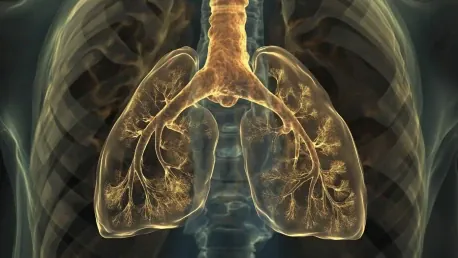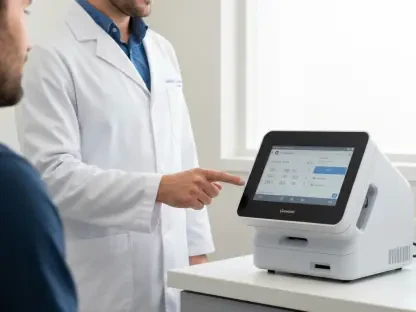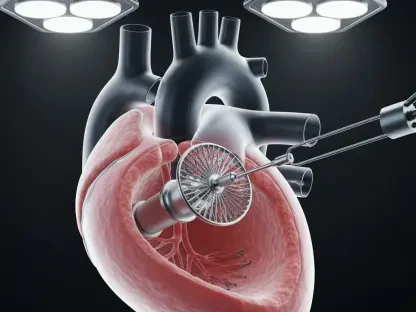The global lung cancer surgery market is on the cusp of transformative growth, driven by several crucial factors from 2025 to 2035. Lung cancer remains the leading cause of cancer-related deaths worldwide, with over 1.8 million recorded fatalities in 2020 alone. Surgical interventions such as lobectomy and minimally invasive procedures play a vital role in the treatment of early-stage lung cancer, offering significant curative potential and improving survival rates. The incidence of cancer continues to rise globally, spurred by factors like smoking, air pollution, and genetic predispositions. As a result, the demand for effective lung cancer surgery is projected to grow substantially.
Rising Incidence and Demand for Advanced Surgical Interventions
Lung cancer continues to present a significant health challenge globally, with various factors like smoking, air pollution, and genetic predispositions contributing to its rising incidence. The increasing number of lung cancer cases has created a substantial demand for advanced surgical interventions. Surgical procedures like lobectomy and minimally invasive techniques are crucial in treating early-stage lung cancer, providing significant curative potential and improving survival rates.
The lung cancer surgery market was valued at approximately USD 5.81 billion in 2023, and it is projected to reach USD 8.34 billion by 2032, growing at a compound annual growth rate (CAGR) of 4.1% from 2024 to 2032. This growth underscores the disparities across different regions and the evolving treatment paradigms. Market dynamics showcase changes in the surgical approach, influenced by tumor size, location, patient health, and cancer stages. These factors contribute to shaping the strategies adopted by healthcare professionals to provide the most effective treatments for patients.
Technological Advancements in Lung Cancer Surgery
Technological advancements play an integral role in the expansion and innovation within the lung cancer surgery market. The trend towards minimally invasive surgical techniques, such as video-assisted thoracoscopic surgery (VATS) and robotic-assisted surgery, has revolutionized lung cancer treatment by reducing patient trauma, improving recovery times, and enhancing surgical outcomes. These minimally invasive procedures can reduce recovery time by 40% and shorten hospital stays, driving a marked shift away from traditional open surgery. However, open surgery remains necessary for complex cases where more extensive intervention is required.
The increasing availability of AI tools, exemplified by Sybil, aids in early cancer detection, allowing for quicker diagnosis and enabling more timely surgical interventions. AI tools like Sybil have improved early diagnosis accuracy to 86–94%, facilitating timely and effective surgical interventions and significantly enhancing the likelihood of successful treatment outcomes. By integrating AI and advanced imaging technologies, surgeons can more accurately assess and plan each patient’s surgery, optimizing results and minimizing complications.
Regional Dynamics and Market Segmentation
Geographically, North America dominates the lung cancer surgery market, accounting for 33.5% of the share due to advanced healthcare infrastructure and a strong preference for technologically advanced treatments. This region benefits from substantial investments in research and development and a highly skilled medical workforce. In contrast, the Asia-Pacific region is expected to grow rapidly, driven by pollution-related cases and ongoing healthcare investments in emerging economies like China and India. The rapid economic development in these countries is leading to improved healthcare facilities and greater access to advanced medical treatments for the population.
The lung cancer surgery market is segmented based on product type, surgery type, procedure, cancer stage, and end-user. The robotic-assisted surgery systems segment dominated the market in 2023, accounting for 23.4% of the market share. These systems are preferred for their precision, minimal invasiveness, and ability to enhance complex procedures. The monitoring and visualization systems segment, including augmented fluoroscopy and cone-beam CT technologies, is expected to grow rapidly due to continuous innovations in imaging. These advances allow for better diagnostics, improved accuracy during surgeries, and enhanced patient outcomes.
Key Drivers and Challenges
The growth of the lung cancer surgery market can be largely attributed to the rising incidence of lung cancer, technological advancements, and early detection initiatives. Factors such as smoking, air pollution, and genetic predispositions contribute to the increasing global incidence of lung cancer, creating a demand for advanced surgical interventions. The adoption of video-assisted thoracoscopic surgery (VATS) and robotic-assisted systems has proven to reduce trauma and recovery times by 40%, thereby vastly enhancing patient outcomes and overall quality of care.
However, the growth of the lung cancer surgery market is not without its challenges. High treatment costs and limited access to healthcare in low-income regions present significant barriers. Lung cancer treatments, including surgery and immunotherapy, are expensive, with certain drugs like Keytruda priced at up to $15,000 per month. These high costs restrict access to treatment in several regions, significantly impeding market growth. Additionally, there is a notable shortage of skilled thoracic surgeons, particularly in developing nations. This shortage leads to delays in treatment and poorer patient outcomes, necessitating comprehensive efforts to address these issues effectively.
Competitive Landscape and Recent Developments
The lung cancer surgery market ecosystem is complex and involves a variety of stakeholders, including medical device manufacturers, pharmaceutical companies, healthcare providers, and research institutes. Key players such as Intuitive Surgical, Medtronic, and Johnson & Johnson lead the market through innovations in robotic surgery, stapling technologies, and minimally invasive devices. These companies focus heavily on research and development to advance precision surgery and improve patient outcomes by leveraging robotic platforms and AI-driven systems. Their commitment to innovation has contributed significantly to the progress in lung cancer surgeries.
Recent developments in the lung cancer surgery market include the introduction of advanced diagnostic and surgical tools such as the Olympus BF-UC190F bronchoscope, which enhances diagnostics and aids in better tumor identification. Similarly, Philips launched the Azurion Lung Edition, which integrates 3D imaging for real-time surgical guidance, thus improving surgical accuracy. Additionally, Johnson & Johnson acquired Auris Health to expand its robotic surgery capabilities, reflecting the growing emphasis on robotic-assisted surgery in lung cancer treatment.
Conclusion and Future Outlook
The global lung cancer surgery market is poised for significant growth from 2025 to 2035, driven by various critical factors. Lung cancer remains the top cause of cancer-related deaths globally, with over 1.8 million fatalities reported in 2020 alone. Surgical options, including lobectomy and minimally invasive procedures, are crucial in treating early-stage lung cancer. These interventions significantly improve survival rates and offer substantial curative potential.
The global incidence of cancer continues to rise, driven by smoking, air pollution, and genetic factors. Consequently, the demand for effective lung cancer surgeries is expected to increase markedly. Furthermore, advancements in surgical techniques and technology, such as robotic-assisted surgeries, have reduced recovery times and complication rates, making surgery a more viable option for many patients.
Healthcare systems worldwide are also investing more in cancer treatment infrastructure, enabling broader access to advanced surgical care. Efforts to improve early detection of lung cancer through screening programs are likely to contribute to the growing number of patients eligible for surgical interventions. As a result, the lung cancer surgery market is projected to experience substantial growth in the coming decade, addressing a critical global healthcare need.









